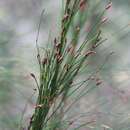en
names in breadcrumbs


Restio's is 'n groep monokotiele plante wat tot die familie Restionaceae behoort. Die genus Restio behoort daartoe, maar die naam word ook vir ander genera aangewend.
Restio's is rietagtige plante wat kenmerkend aan die Kaapse floraryk se fynbos is. In die ander deel van dié floraryk, die renosterveld, is hulle nie aanwesig nie.
Restio's is tweehuisige plante. Party van hulle word vir besems of vir grasdakke gebruik.[1] Die meeste restio's kom uit die Kaap, maar daar is ook Australiese spesies, soos van die genus Baloskion en party groei in Nieu-Seeland. Restio's word nou in tuine oor die hele wêreld gekweek. [2] Hul blare is gereduseer tot skedes en die stingels (halms) is groen en het die fotosintese oorgeneem. Daar is 330 restio-spesies in Afrika, 150 in Australië, 4 in Nieu-Seeland, 1 in Suid-Amerika en 1 in Suidoos-Asië.[3]
Restio's is 'n groep monokotiele plante wat tot die familie Restionaceae behoort. Die genus Restio behoort daartoe, maar die naam word ook vir ander genera aangewend.
Restio's is rietagtige plante wat kenmerkend aan die Kaapse floraryk se fynbos is. In die ander deel van dié floraryk, die renosterveld, is hulle nie aanwesig nie.
Restio's is tweehuisige plante. Party van hulle word vir besems of vir grasdakke gebruik. Die meeste restio's kom uit die Kaap, maar daar is ook Australiese spesies, soos van die genus Baloskion en party groei in Nieu-Seeland. Restio's word nou in tuine oor die hele wêreld gekweek. Hul blare is gereduseer tot skedes en die stingels (halms) is groen en het die fotosintese oorgeneem. Daar is 330 restio-spesies in Afrika, 150 in Australië, 4 in Nieu-Seeland, 1 in Suid-Amerika en 1 in Suidoos-Asië.
Restio is a genus of flowering plants within the family Restionaceae, described in 1772.[5][3] The entire genus is endemic to South Africa (Cape Province and KwaZulu-Natal).[4]
In common with a number of other genera in the Restionaceae, restios are widely cultivated for use as garden ornamentals for their attractive nodular foliage. They are mildly frost hardy.
Many species formerly included within the genus Restio are now classified into a number of other genera including Acion, Baloskion, and Eurychorda.
Restio is a genus of flowering plants within the family Restionaceae, described in 1772. The entire genus is endemic to South Africa (Cape Province and KwaZulu-Natal).
In common with a number of other genera in the Restionaceae, restios are widely cultivated for use as garden ornamentals for their attractive nodular foliage. They are mildly frost hardy.
Species Restio acockii Restio adpressus Restio affinis Restio albotuberculatus Restio alticola Restio andreaeanus Restio anomalus Restio arcuatus Restio aridus Restio asperus Restio aureolus Restio bifarius Restio bifidus Restio bifurcus Restio bolusii Restio brachiatus Restio brunneus Restio burchellii Restio caespitosus Restio calcicola Restio capensis Restio capillaris Restio cedarbergensis Restio cincinnatus Restio clandestinus Restio coactilis Restio colliculospermus Restio communis Restio confusus Restio constipatus Restio corneolus Restio curvibracteatus Restio curviramis Restio cymosus Restio debilis Restio decipiens Restio degenerans Restio dispar Restio distans Restio distichus Restio distractus Restio distylis Restio dodii Restio durus Restio duthieae Restio echinatus Restio egregius Restio ejuncidus Restio eleocharis Restio elsieae Restio esterhuyseniae Restio exilis Restio femineus Restio festuciformis Restio filicaulis Restio filiformis Restio fourcadei Restio fragilis Restio fraternus Restio fuscidulus Restio fusiformis Restio gaudichaudianus Restio gossypinus Restio harveyi Restio helenae Restio hyalinus Restio hystrix Restio implicatus Restio impolitus Restio inconspicuus Restio ingens Restio insignis Restio inveteratus Restio involutus Restio karooicus Restio laniger Restio leptoclados Restio leptostachyus Restio levynsiae Restio longiaristatus Restio luxurians Restio macer Restio marlothii Restio micans Restio miser Restio mkambatiae Restio monanthos Restio monostylis Restio montanus Restio muirii Restio multiflorus Restio nanus Restio nodosus Restio nubigenus Restio nudiflorus Restio nuwebergensis Restio obscurus Restio occultus Restio ocreatus Restio pachystachyus Restio paludicola Restio paludosus Restio paniculatus Restio papillosus Restio papyraceus Restio parthenocarpos Restio parvispiculus Restio patens Restio peculiaris Restio pedicellatus Restio perplexus Restio perseverans Restio pillansii Restio praeacutus Restio pratensis Restio pulcher Restio pulvinatus Restio pumilus Restio purpurascens Restio pygmaeus Restio quadratus Restio quinquefarius Restio ramosissimus Restio rarus Restio rigidus Restio rigoratus Restio rivulus Restio rottboellioides Restio rudolfii Restio rupicola Restio sabulosus Restio saroclados Restio saxatilis Restio scaber Restio scaberulus Restio schoenoides Restio secundus Restio sejunctus Restio setiger Restio sieberi Restio similis Restio singularis Restio sporadicus Restio stereocaulis Restio stokoei Restio strictus Restio strobilifer Restio subtilis Restio subverticillatus Restio tenuispicatus Restio tenuissimus Restio tetragonus Restio triflorus Restio triticeus Restio tuberculatus Restio uniflorus Restio unispicatus Restio vallis-simius Restio verrucosus Restio versatilis Restio vilis Restio villosus Restio vimineus Restio virgeus Restio wallichii Restio wittebergensis Restio zuluensis Restio zwartbergensisMany species formerly included within the genus Restio are now classified into a number of other genera including Acion, Baloskion, and Eurychorda.
Restio es un género con 88 especies de plantas herbáceas perteneciente a la familia Restionaceae. Son endémicas de sur de África y Madagascar. Algunas especies se utilizan como planta ornamental para los jardines.
Restio es un género con 88 especies de plantas herbáceas perteneciente a la familia Restionaceae. Son endémicas de sur de África y Madagascar. Algunas especies se utilizan como planta ornamental para los jardines.
Restio é um género botânico pertencente à família Restionaceae[1].
Restio é um género botânico pertencente à família Restionaceae.
«Restio — World Flora Online». www.worldfloraonline.org. Consultado em 19 de agosto de 2020Restio là một chi thực vật có hoa trong họ Restionaceae.[1]
Restio là một chi thực vật có hoa trong họ Restionaceae.